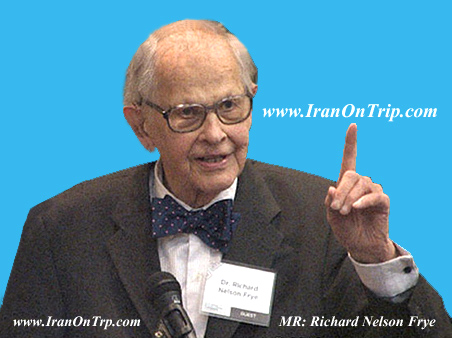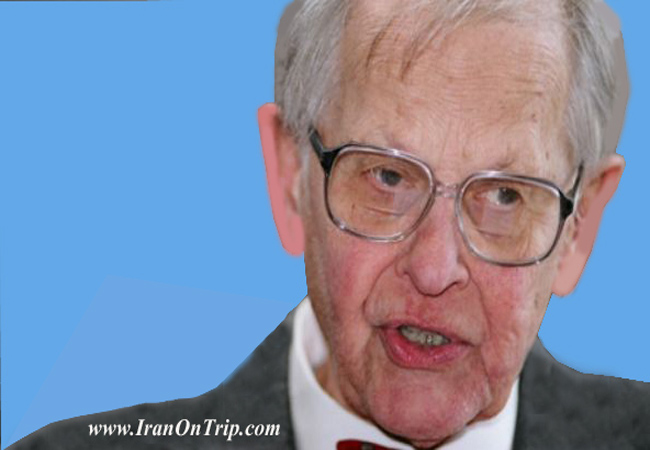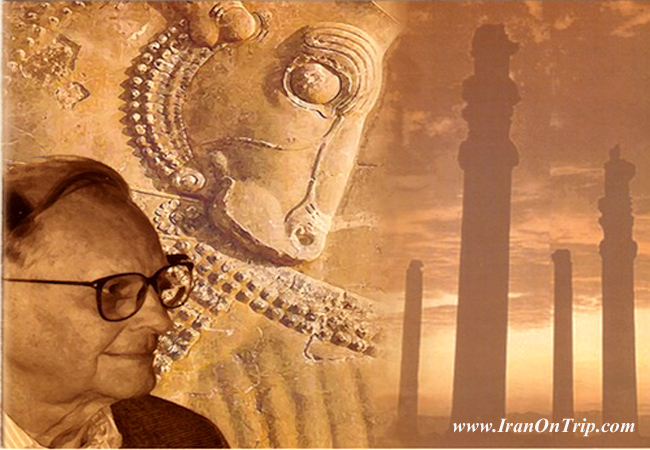(Richard Nelson Frye (American Iranologist

Richard Nelson Frye was an American scholar of Iranian and Central Asian Studies, and Aga Khan Professor Emeritus of Iranian Studies at Harvard University.
Born: January 10, 1920, Birmingham, Alabama, United States
Died: March 27, 2014, Boston, Massachusetts, United States
Books: The Cambridge History of Iran, The heritage of Central Asia from antiquity to the Turkish expansion, Islamic Iran and Central Asia
Education: Harvard University (1946), University of Illinois at Urbana-Champaign
Awards: Guggenheim Fellowship for Humanities, US & Canad
American Iranologist Richard Nelson Frye In Esfahan

Richard Nelson Frye With President Khatami of Iran

Above: With President Khatami of Iran at Ilex Foundation and
Olga Davidson, founder, 2006Left : Delivering inaugural address at Razi Lectrures held at
California State University, Fullerton, 2007Aptly referred to as “dean of the world’s Iranists” among scholars,
Richard Nelson Frye ofHarvard University has researched and taught the cultural history of Iran,
Central Asia andthe Near East for over six decades
Richard Nelson Frye (January 10,1920 - March 27, 2014)

American scholar of Iranian and Central Asian studies, professor Richard Nelson Frye has passed away at the age of 94.Famed as “dean of the world’s Iranologists” among scholars, Frye died in Boston on March 27, 2014.Iranian Foreign Minister Mohammad Javad Zarif and the Director of the Islamic Culture and Relations Organization (ICRO) Abouzar Ebrahimi Torkaman have expressed their condolences on the loss of the great scholar.“His death deeply saddened all those who were interested in Persian studies,” Torkaman stated.Frye founded Middle Eastern studies department at Harvard University. His works and researches on Persian culture and civilization have played significant role in expanding Persian studies across the world.He has researched and taught the cultural history of Iran, Central Asia and the Near East for over six decades. He had great affection for Iran and the Iranian people and traveled to Iran several times.He wrote more than 20 books and over 150 articles about the ancient Iranian culture.Frye, in his will, had expressed his wish to be buried next to the Zayandehroud River in his beloved city, Isfahan.While two American Iranologists, Arthur Pope and Phyllis Ackerman, are already buried in Iran, Fry’s request was approved by former president Mahmoud Ahmadinejad in September 2007.
“They are very hospitable people. I love them very much,” Frye said in his talking about Iranians.
Richard Nelson Frye (January 10,1920 - March 27, 2014)

The career of Professor Richard Frye in Iranian studies spanned more than half a century during which time he was fully occupied researching, writing, and teaching. Our field is so much richer because of his dedication to it and his indefatigable efforts to advance Iranian studies in fields as diverse as history, historical geography, linguistics, art and archeology, numismatics, and sigillography.
Prof. Frye was primarily known as a scholar of Iran and Iranian Central Asia; but the scope of his studies and contributions was much wider. His research interests comprised also Byzantine, Caucasian, and Ottoman history, Eastern Turkistan, ancient and medieval Iranian art, Islamic art, Sufism, Chinese and Japanese archeology, and a variety of Iranian and non-Iranian languages including Avestan, Old Persian, Middle Persian, Parthian, Sogdian, Khotanese, and Bactrian, New Persian, Arabic, Turkish, and even Chinese, beside research languages which include French, German, Italian, and Russian.
Prof. Frye was born on January 10, 1920 of Swedish parents who immigrated to the United States and took residence in Birmingham, Alabama, but later moved to Danville, Illinois. He entered the University of Illinois at Urbana to study philosophy, but he was gradually drawn towards history and was introduced to Ottoman and Near Eastern as well as Far Eastern, Armenian, and Eastern European history. In the summer of 1938, one year before he received his B.A., he attended a summer school in Princeton University and studied Arabic under Philip Hitti and Turkish under Walter Wright and Islamic Art with Mehmed Aga-oglu. Here he met Albert Olmstead, the author of History of the Persian Empire (Chicago, 1948), who stirred in him an interest in Achaemenid history and the then recent discoveries made by Chicago’s Oriental Institute in Persepolis. He visited the Oriental Institute several times, where he met Olmstead again, but also made the acquaintance of George Cameron, who was studying the Persepolis Elamite Tablets, and Neilson Debevoise, the author of A Political History of Parthia (Chicago, 1938). He also took a seminar on Central Asia and Eastern Turkistan, which fostered a deep interest for the region in him.
For graduate studies he chose Harvard and entered the History Department in 1939, where he received an M.A. in History and Semitic Languages in 1941. About the same time, a stipend was offered him from Yenching Institute with the stipulation that he would study Chinese and Chinese history. In the summer of 1942 Frye attended the summer school at Princeton for the third time where he studied Persian under Mehmed Semsar and with whom he began work on the translation of Narshakhi’s History of Bukhara, which became the subject of his Ph.D. dissertation at Harvard.
During World War II he was placed in charge of the Afghan Desk in Washington D.C. In 1942 he traveled to Afghanistan and stayed there for two years to monitor German and Japanese activities among Afghan tribes. In 1944 through 1945 we find him residing in Turkey to interview the Tatars who had arrived from Russia. Few scholars have found such diverse opportunities to visit so numerous places and to meet great scholars in different fields of study.Far from being a sedentary or abstract scholar, Frye, a true peripatetic researcher, more than satisfied his ambulatory urges, traveling from west to east and from north to south, making a point of visiting and studying first hand the places which fell within the orbit of his studies. He traversed the arid lands and mountainous terrains between Cairo and Kabul, crossing Kerman and Baluchistan to visit Sistan and Kuh-e Khajeh, he marched trough valleys and climbed mountains in Afghanistan to visit historical monuments, he suffered heat and thirst in crossing the Persian kavir to reach Biyabanak and Khor (the dialect of which he studied and published), and he passed through inhospitable lands in Central Asia and Chinese Turkistan to visit Buddhist and Manichean monuments.
He was one of the rare scholars who cover both fields of Iranian studies: pre-Islamic and post-Islamic. Since he was best known as a scholar of pre-Islamic Persian history and languages, one might be surprised to learn that one of the first articles he published was “Abu Muslim in the Abbasid Revolt” (The Moslem World, 37, 1947, pp. 28-38); and the first book he edited was The Near East and the Great Powers (Cambridge, Mass., 1951).
His The Heritage of Persia (London, 1962), which has become a classic, is an excellent introduction to the history and culture of ancient Iran, discussing its linguistic and ethnic variety, Iranian religious experience, Iranian art, and the course of Iranian history to the fall of the Sasanian Empire. The political history of Sasanian dynasty in the third volume of the Cambridge History of Iran is also by his pen and is appended by a vary useful listing of Sasanian kings with Middle Persian version of their names, the Classical form of these names and the regnal years of Sasanian monarchs.
Prof. Frye’s epigraphical and sigillographical skills was demonstrated in Sasanian Remains From Qasr-i Abu Nasr; Seals, Sealings, and Coins (Cambridge, Mass., 1973), edited by him with major contributions by Prudence Harper. The chapters, which deal with the reading of the seal impressions, bullae, and ostroca found at the site, were contributed by Frye. His The Golden Age of Persia (London, 1975) is in fact a sequel to his The Heritage of Persia. It deals with the history of Iran following the Arab conquest, the rise of Islamic Persian culture under the Saffarids and particularly the Samanids, and its flourishing under the Ghaznavids and the Saljuks up to the Mongol period. Later, Prof. Frye published a fuller history of pre-Islamic Persia as The History of Ancient Iran (Munich, 1983), which pays particular attention to the history of Eastern Iran (the Kushans, the Hephtalites, and other peoples). Frye’s The History of Ancient Iran and The Golden Age of Persia, put together, provide a narrative of Persian history until mid thirteenth century, which is far more up-to-date than many previous attempts.
Prof. Frye’s The History of Bukhara (Cambridge, Mass., 1954), a translation of Narshakhi’s Tarikh-e Bokhara, makes available to the English readers a very important history of a major Iranian cultural center in Sogdiana. All together he authored, translated, or edited some sixteen books. But the bulk of his contribution can be found in his numerous articles and reviews, listed by Shapur Shahbazi in the Bulletin of the Asia Institute, volume 4 (1990), published “In honor of Richard Nelson Frye” (the first part edited by Carol Bromberg, Bernard Goldman and the second part by Oktor Skjaervø and Shapur Shahbazi).
Prof. Frye had not been only a prolific researcher and author, but also an active campaigner, promoting through his teaching as well as a number of project initiatives and administrative and semi-administrative undertakings the cause of Iranian and Central Asian studies. Remarkable among them were his revival in Shiraz (1974) of the Asia Institute founded by A. U. Pope and its Bulletin, and his helping to establish the Committee on Inner Asian Studies at Harvard (1983).
I should like to mention two features, which I have admired in Prof. Frye’s writings. One is his open-mindedness about views and theories concerning Persian history and culture. As happens also in some other fields, there are many controversies in Iranian studies, which have occupied and preoccupied Iranologists for years. Most scholars are tenaciously attached to their own opinions, and consider differing views a sign of ignorance, aberration, or both. Friendships have been disrupted, blood has reached the boiling point, and harsh words and critical attacks have been launched against the holders of other views. Such are, for instance, controversies about the date of Zoroaster, the religion of the Achaemenids, the veracity of Darius in his inscriptions, concerning his accession to the throne which Herodotus repeats about the murder of Bardia (Smerdis), the youngest son of Cyrus, and next-of-kin marriages in ancient Iran. I never saw Prof. Frye condemn an opposing view in vituperative language. He always showed, on the contrary, openness to views other than his own in discussing such controversies. Very often he posed the question, pointed out different theoretical solutions, and left it at that. Frequently, his discussion ended with a question, pointing to an absence of dogmatic attitude.
The other feature is his treatment of the Central Asian history. The term ‘Central Asia’; so fashionable these days, is of recent invention. Earlier the region was called Turkistan on account of the gradual domination, from about the eleventh century, of Turkic tribes over the region, as one can see in the title of W. W. Barthold’s admirable Turkestan Down to the Mongol Invasion (English trans., London, 1928), or else, by its territorial components. The Soviet Union, interested in driving a wedge between the past of these regions and their Soviet status, welcomed the term as neutralizing the historical claims of the Persians and the pan-Turkist advocates alike. It pushed, with the help of some Eastern European countries, Hungary in particular, to give the term a historical reality and persuade UNESCO to undertake a number of projects under this term. This is all very fine, as long as it does not deny or obscure the fact that the oldest historical layer of civilization and one which shaped the course of the early history of the region and is still an important cultural element in the area is Iranian. Prof. Frye was at pains to point out this reality through his many articles and more recently his The Heritage of Central Asia: from Antiquity to the Turkish Expansion (Princeton, 1996), where the heritage of Sogdiana, Parthia, Bactria, Khwarazmia, and other areas in the region are discussed.
In fact, Prof. Frye, throughout his career was a friend of Iran and Iranian peoples, whether they live in Persia, Afghanistan, Tajikistan, Kurdistan, Baluchistan, Caucasus, or in Diaspora. He lived up to the sense of the sobriquet Iran-dust ‘lover of Iran’ that the late ‘Ali-Akbar Dehkhoda bestowed upon him in 1953 and which he had used since. But this is not a one-sided love; it is mutual; Iranians, in appreciation of his outstanding efforts on behalf of their history and culture, have come to love him as much as he had loved them.
Memorial donations can be made to:
Richard Nelson Frye Lecture Fund (370-504601)
Faculty of Arts & Sciences
Harvard University
Cambridge, MA 02138
Ehsan Yarshater
March 31, 2014
.....
.....
.....

.jpg)



























